6 Human Prehistory: 300,000 – 3500 B.C.E.
Cynthia Smith and Eugene Berger
INTRODUCTION
DISCOVERY — Deliberate burial 80,000 years old
The study of “human antiquity” or man’s earliest origins is surrounded by passion, controversy, and a deep well of curiosity. Our interest in our earliest origins has not only given birth to fictional characters like Indiana Jones and Captain Kirk, it is also largely responsible for the growth of archaeology in the early 20th century. Western scholars and explorers were not content with simply reaching remote places; they were curious about the Earth’s earliest human inhabitants. Archaeologists and paleoanthropologists eventually created an entirely new field of historical investigation: prehistory. Multiple pioneers hack through underbrush or spend months excavating Paleolithic sites and our understanding of the past is constantly changing based on new evidence discovered, as well as new perspectives and approaches, all of which lead to new interpretations. This is especially true as we attempt to trace the earliest beginnings of the human story.
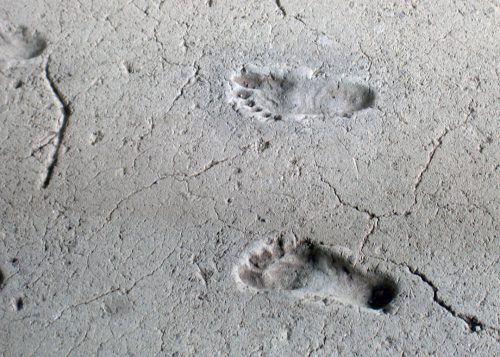
Every year new findings, enhanced by application of new technologies, provide us a clearer view of ancient experiences and developments. Look at the newspaper any given week and you will find reports of new archeological discoveries, new theories proposed, or new insights gained from genetic analyses. For example recent archaeological findings of what appear to be ancient footprints in New Mexico raises the strong possibility human migration into the Americas took place far earlier than previously thought. Advanced genetic sequencing analysis has revealed far more complex human migration patterns into ancient Europe, as well as evidence of more interactions and interbreeding between Homo Sapiens and Neanderthals.
Another intriguing recent find was the discovery of the oldest ‘deliberate’ human burial in Africa. Remains of a 2½ to 3 year old child were found buried, and evidence indicates the body was wrapped, perhaps with leaves, with the head supported on some form of pillow as the body was laid to rest. Clearly great care was given to the burial of this child. This physical evidence tells us humans took conscious care to bury their dead at least 80,000 years ago in Africa, the ‘cradle’ of Homo sapiens (modern human) development. Burial reflects a conscious, ritual response to death and the loss of a family or community member. This is considered a distinctly ‘human’ behavior. Evidence of the earliest known beginnings of ritual burial enables us to better understand human cultural evolution. Based on evidence we continue to discover, and ongoing efforts to analyze and find meaning from this evidence, we can continually refine the fascinating story of human history and experiences.
OVERVIEW
History is the story of humans and telling this story depends entirely on the sources available. Without evidence of past events and experiences, we cannot make and support conclusions. Written texts are the sources most historians are trained to work with and what historians are most comfortable using. Yet written language is a relatively recent invention (around 5,000 years old), therefore much of what we know about human beginnings is based on the findings of other disciplines such as geology, botany, and archaeology. Archaeologists have done the fundamental work excavating and analyzing physical evidence relating to our prehistoric ancestors. Until the middle of the last century, it was difficult to understand migration patterns and chronology without a method to determine the age of relics such as a human skull or a cutting tool. Archaeologists in the 1930s and 40s used imprecise terms like “stone bowl cultures,” a nomenclature that referred more to details of the articles unearthed rather than their historical context.[1] This began to change with the advent of radiocarbon or C14 dating in the 1940s. Through this method, thousands of organic archaeological materials could be placed in their proper historical context even without textual evidence. For artifacts over 40,000 years old, the amount of radioactive carbon we can recover doesn’t permit accurate measurement. We do, however, have a number of techniques to trace human origins even further back, including aerial photography, side-scanning radar, and potassium-argon dating. All these techniques supplement the lack of radioactive carbon; they don’t date the organic material but the terrain in which they were found allows us to trace human origins back millions of years to the beginnings of bipedalism.
The goal of this chapter is not to trace human evolution from its beginnings but to set the scene for the beginnings of civilization. We explore why hominids moved, how they survived, and how they came to develop agriculture. We also address why humans in far flung parts of the world responded in similar ways to changing conditions, developing the structures that came to define ‘civilization’ at roughly the same time. This chapter begins with the origins of bipedalism some eight million years ago and brings us up to eight thousand years ago, the start of the Neolithic Era or “new stone age.” Bipedal hominids developed during the Pliocene era, and our closest ancestors were evident during the more recent Pleistocene era. Modern Homo sapiens appeared during the Holocene period. During the Holocene, humans perfected tool usage during the Paleolithic era, and ushered in agriculture during the Neolithic era. This chapter ends as humans entered the Bronze and Iron Ages.
HUMAN BEGINNINGS IN AFRICA
Climate, Hominin Evolution, and Migrations
“Hominids” refers to all Great Apes, including humans and their ancestors. “Hominins” is often used when speaking more specifically about modern humans and their more recently extinct ancestors. The fossil record in Africa clearly establishes that a human lineage diverged there from African apes sometime between eight to six million years ago. Beginning as far back as eight million years ago, various species of hominids (ancestors of modern humans or Homo sapiens) began to walk upright. This bipedalism allowed these hominids to use their hands to develop, craft, and use tools. Bipedalism also eventually contributed to a move out of forests into the savanna, and turned hominids into big game hunters and gatherers. Paleoanthropologists once theorized hominids became bipedal to adapt to life in the grasslands. However, the fact that fossils of bipedal hominids were found alongside fossil remains of wood, seeds, and other forest dwellers has cast some doubt on that theory. Bipedal hominids may have lived in the forest for some time. While some bipedal hominids may have stayed in the forest, climate changes did drive others to move into new areas within Africa and beyond it.
During the Pliocene epoch (5–1.6 million years ago), a series of environmental changes made grasslands even more prevalent, leading to a transformation geologists call the “turnover-pulse hypothesis.” Animals with adaptations such as angled knee joints and arched feet survived on the grasslands, while those with longer arms or curved fingers who were better suited to the woodlands did not. For hominids, this favorable grassland environment meant the “development of several closely related species. Large-toothed hominids known as robust australopithecines appeared in Southern and Eastern Africa.”[2] Towards the end of the Pliocene, around 2.4 million years ago, the first members of our genus – homo (Homo habilis) – appeared, the first hominid to make stone tools.
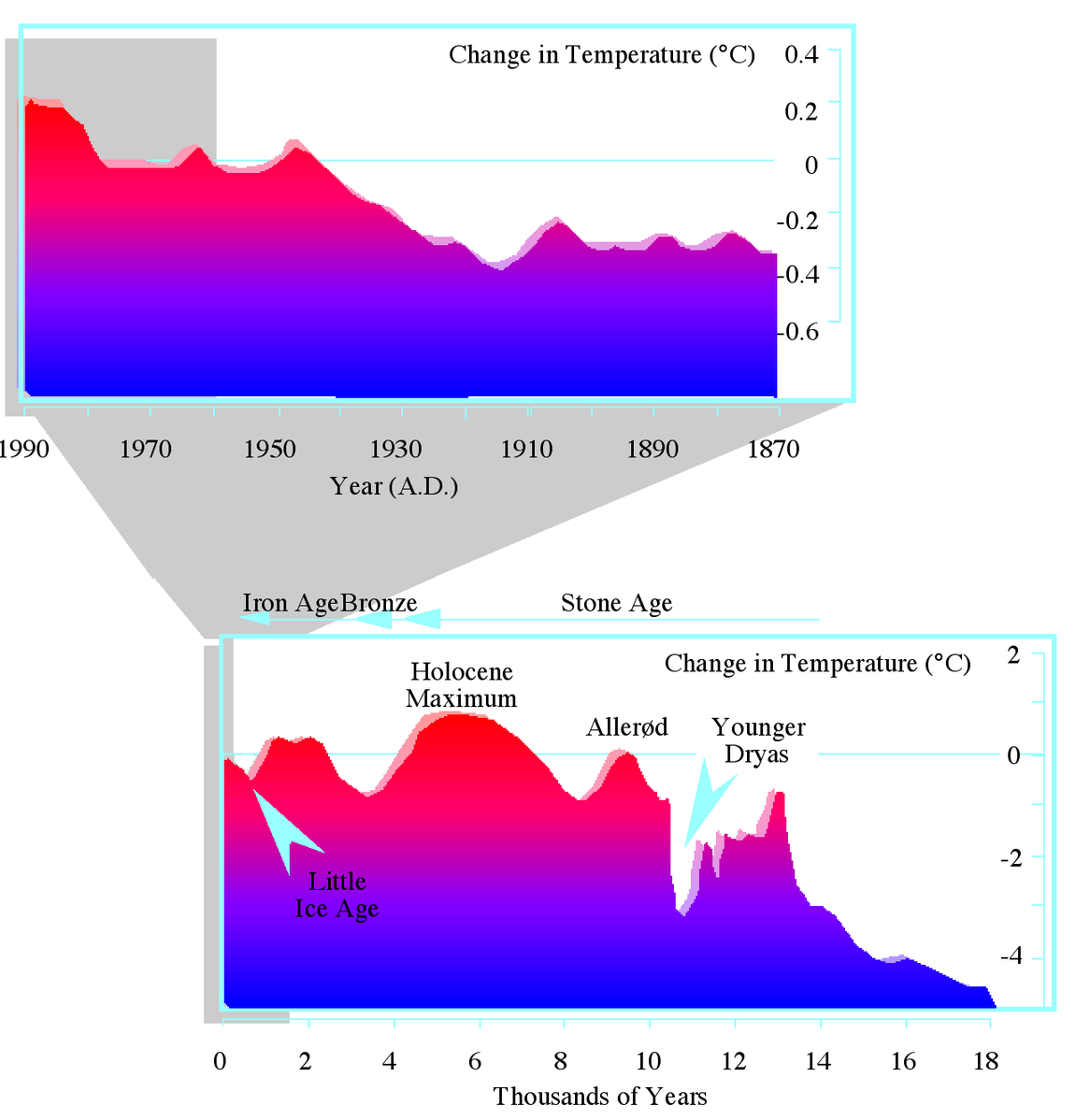
The Pleistocene epoch (1.6 million–10,000 years ago) saw at least twenty-five periods of glaciation and warming. Glaciation resulted from dips in global temperature and had two major effects on hominid development. First, with sea levels dropping due to glaciation, hominids migrated to Australia and the Americas for the first time. Second, many migrated out of colder climates while those that remained developed physical adaptations. Homo neanderthalensis (Neanderthals), a hominid that disappeared 28,000 years ago, became stockier and more powerful to deal with the difficulties of this icy climate.
While not as dramatic as previous developments, the Holocene period encompassed significant climatic events. The Younger Dryas event (c. 12,000 BCE) was a drop in global temperatures accompanied by a corresponding change in vegetation distribution. Reduced rainfall from 2200–1900 BCE made conditions very difficult for those living in the Eastern Mediterranean. Finally, the Medieval Warm Period (approximately the 19th-14th centuries CE) represents “one of the most recent periods of climate change.”[3]
Despite these fluctuations, the Holocene era was a period when climate conditions made possible the agricultural revolution, and thus settled civilizations. Some scientists now argue the Holocene period is over, replaced by the Anthropocene – a period during which human activities, rather than natural systems, have become the dominant influence on the earth’s climate and environmental functions. Those who agree that our species is currently living in an Anthropocene era point to the many ways human activities increasingly impacted global environmental and climate functions.
Like neanderthalensis, Homo sapiens, Homo erectus, Homo habilis, and other hominids all reacted to changing climate conditions. Homo erectus and Homo habilis migrated, hunted, and used fire, while neanderthalensis had some use of language and tools and buried their dead. For millions of years, hominids had been using slivers of volcanic stone and cutters, probably to hack through animal skin. The cutters were often found close together, suggesting early hominids had a division of labor between hunters who would pursue their prey and butchers who could wait nearby at the butchering site.
There is evidence of task division by gender among neanderthalensis. Multiple sites in Europe show different patterns of wear on male and female teeth, indicating a gendered task division in tasks where teeth were used to hold, break, or strip objects.[4] By 25,000 years ago, only Homo sapiens sapiens, our species, survived; all other hominins were extinct. Paleoanthropologists attribute this survival to larger brains, durability, and the ability to adapt to changing environmental conditions. Based on migration patterns and archaeological evidence, Homo sapiens sapiens appear to have been the only hominids to build sea-worthy boats, create art, have organized religion, and find ways to live in any climate.[5]
Homo Sapiens Migration
While Homo sapiens were decidedly more advanced than other hominids, when they first moved out of Africa some 45,000 years ago they were only equipped with stone tools for hunting and cutting. Yet despite initial limitations, 30,000 years later Homo sapiens inhabited almost every environment on earth, with a presence in every continent except Antarctica. Homo sapiens moved further and faster than all other hominids, with their migration accelerating close to 40,000 years ago. Modern humans (50,000–10,000 years ago) migrated to all the continents except Antarctica, moving first into Australia, Eastern Siberia, the Pacific margins, Japan, and the Americas. Then from 10,000 years ago to 1,500 CE, humans arrived in the Arctic, the Indian Ocean, the deep Pacific, and tropical rainforests. Migration occurred in a “staccato” pattern with the “easiest” areas colonized quickly, while more “difficult” areas remained uninhabited for thousands of years. For example, tropical savannas and grasslands of East Africa were colonized first, as the biomass there effectively sustained the first bipedal hominids.
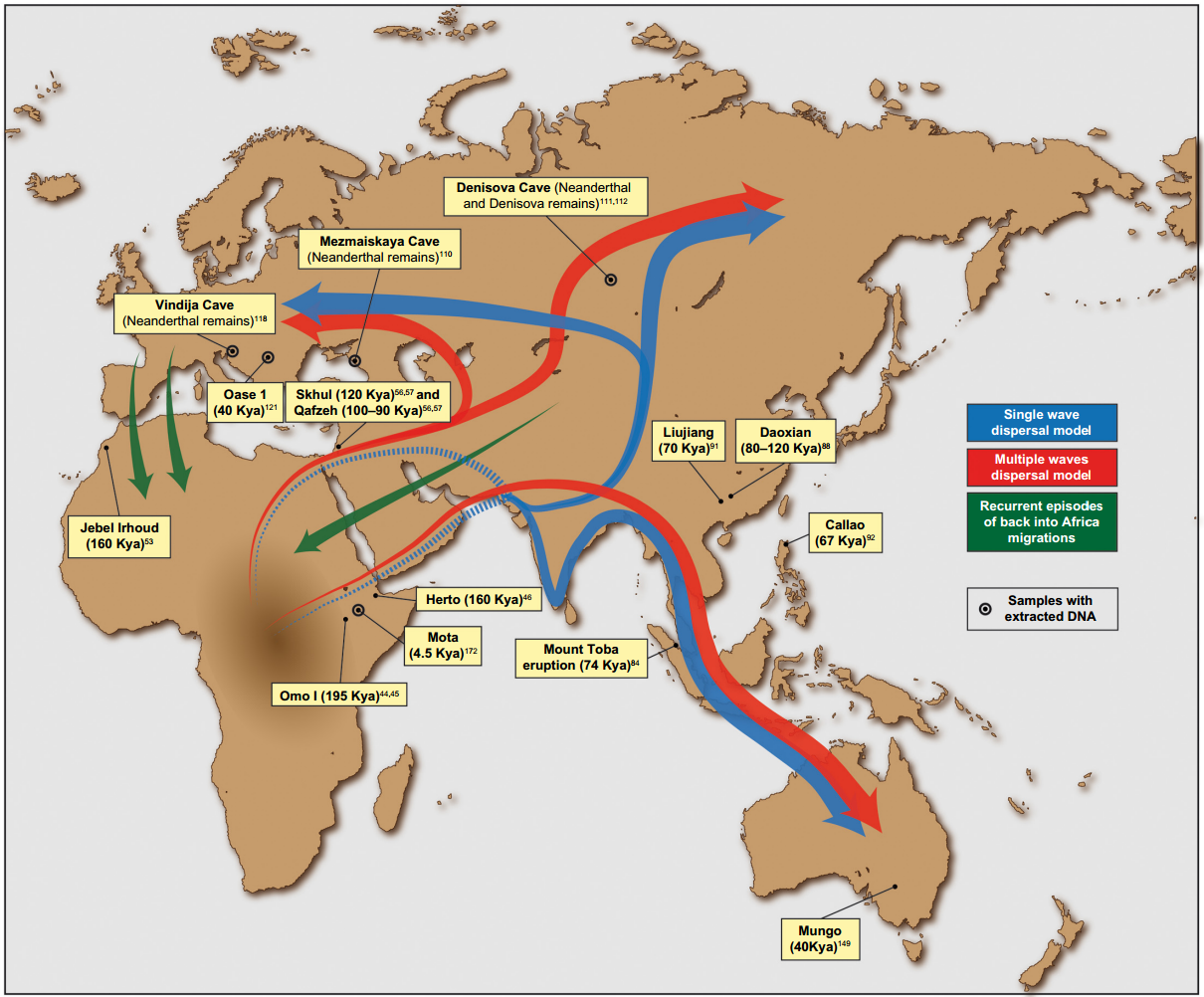
Reading the Past – Human Odyssey Interactive Map
View the interactive map: “Human Odyssey Interactive Map,” California Academy of Sciences.
Hominids first left “sub-Saharan Africa … through the northern savannas, up the Nile corridor or across the straits of Bab el Mandeb to the Arabian Peninsula.”[6] Evidence exists of Homo erectus in Morocco, Chad, and Algeria, and it appears they eventually left Africa via the Arabian Peninsula. After leaving Africa about 1.5 million years ago, choppers, hand axes, and spheroids found at sites like Ubeidiya in Israel put Homo erectus in the Levant. Some scholars argue for the existence of a second migration out of Africa and into the Jordan Valley 500 to 600 thousand years ago.
Learning in Action – Human Species
Watch the video: “One Species, Living World Wide,” Smithsonian National Museum of Natural History.
Link: https://humanorigins.si.edu/multimedia/videos/one-species-living-worldwide
Asia
Some evidence suggests the presence of Homo ergaster and Homo erectus as having occurred in Java over a million years ago. Chinese Homo erectus fossils date between 800,000 to 400,000 years ago. Homo sapiens began to leave Africa around 40,000 years ago, and hunter gatherers appeared in China by the end of the last Ice Age (36,000 to 16,000 BCE) as continental ice in central Asia began to melt.
Europe
Animal bones and pebble tools place hominids near Italy just before the beginning of the Middle Pleistocene (730,000 years ago). This seems to be the first hominid incursion into Europe. Hominid remains in Spain suggest colonization in Iberia up to two million years ago, but there are not nearly enough remains (no more than twenty inhabitants in any given site) to provide any certainty regarding which hominids they correspond to or when they lived there. Either way, colonization of Europe can be considered “late.” This tardiness may have been related to a lack of animal food sources. Not until around 500,000 years ago did “new species of deer, bovid, rhino, and horse appear” in Europe (Gamble 1993, 135). Around the same time, the numbers of cheetah, saber-tooth tiger, and dirk-tooth cat declined in the region, making more carcasses from the prey species available to hominid foragers.
Australia, Papua New Guinea, Sahul
Evidence of tools from 30,000 years ago exists in Australia, and from even longer ago in New Guinea. The lack of an established land crossing meant that an ocean journey of somewhere between 65 and 100 kilometers was required from mainland Asia. This made Australians and New Guineans the first sea-going colonizers. How humans populated Australia is still the subject of some debate between those who support the “coastal hugger” theory and those who support the idea of population by “overlanders.” The more difficult means of populating Australia is overland, as it is more arid than the coasts, and the evidence for tools overland is not as advanced as that for the coast.
Peopling the ‘New World’
North and South America were the last continents to be settled by humans. Most scholars think that the Americas were populated from Beringia over land. Around 12,000 years ago, mammoth hunting became more common and supported larger populations on both the Asian and American sides of Beringia, a landmass that at that time connected North America and Asia, now divided by the Bering Strait. On the Asian side, outlines of houses with stone-lined hearths have been found, indicating permanent settlement that didn’t necessarily have colonization as an end goal. But colonize they did, one group pushing southward between 10,000 and 3,000 years ago and establishing settlements that would become the origins of modern Korean, Japanese, Chinese, and Inuit populations. Another group migrated southeast through Alaska, their descendants making it as far as Chile and Argentina.
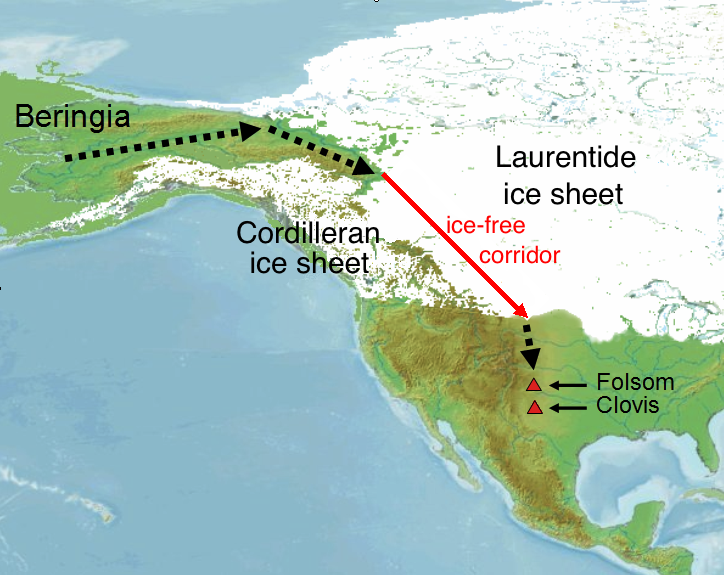
While we know roughly when American colonization began, the pace and means of colonization are still debated. Complicating the discussion of timing is the fact the Late Wisconsin Ice sheet blocked the overland route from about 30,000 years ago, when two sheets merged, up until about 12,000 years ago when they opened after a thaw. Currently only a handful of sites support possible pre-10,000 BCE occupation: Monte Verde in Chile, Meadowcraft near Pittsburgh, and Page-Ladson in Florida. As recently as 2015, excavations at Monte Verde and Chinchihuapi strengthened the possible dating of an earlier human presence to as far back as 17,000 BCE. This date has continued to move back in time as archeologists seek and consider evidence of nomadic humans who did not leave large artifact clusters but may have been present before more sedentary groups.
For now, the clearest evidence for when the Americas were widely populated comes through the Clovis point, a specific arrowhead shape unique in its ubiquity and sophistication. The Clovis point was found in mammoths that had become extinct by 10,500 years ago; this discovery thus means humans were common in North America by then. From Beringia, humans moved at a rate of roughly 10 miles a year until they reached Tierra del Fuego and fully populated the Americas, with the exception of some tropical areas mentioned above.[7]
The Arctic
The first Paleo-Eskimo populations appeared around 4,000 years ago after arriving from Eastern Siberia, populations left behind by the American colonists discussed above. The Arctic climate is harsh and these populations needed sophisticated weapons and tools to be able to survive it, which explains their late arrival. The Arctic colonists expanded rapidly across Alaska, through Canada, and into Greenland, assisted by their arctic tools that included the important toggle headed harpoons to kill walrus and seal.
Moananuiākea (the Pacific)
The origins of Polynesian humans are still debated. Groups of Polynesian mariners existed 50,000 years ago, but they were not colonizers. In fact, many scholars argue that eventual colonization began as exploration. Around 2,500 years ago, we see more permanent settlements in Fiji, Tonga, and other areas of the “remote” Pacific, as remnants of pottery have been found there. Based on linguistic and technological similarities among Polynesian cultures, some scholars argue that Fiji, Samoa, and Tonga were a cultural crucible of sorts. These populations began to colonize Rapa Nui (Easter Island), Hawaiʻi, and Autearoa (New Zealand) about and beyond 1,000 CE.
The Pacific was a marine highway, where currents and winds were well-known and frequently used by mariners. Migrating humans were much more likely to wander aimlessly on land than they were to let currents take them to unknown parts of the ocean. Pacific mariners tacked to use the winds in their favor and Pacific mariners were too adept at seafaring to suggest a simple casting out of people into the Pacific in hopes of finding land. Once Pacific colonization did commence, settlers were very deliberate about it, taking with them families, and plants, and animals. It seems that they had every intention of recreating “home.”
By 20,000 years BCE, evidence clearly shows Homo Sapiens inhabited all the major continental land masses of the earth, including Africa, Australia, Eurasia, and the Americas, but excluding Antarctica which has never had a self-sustaining human population for obvious reasons. Tests on contemporary human females show them to have enough similarity in their mitochondrial DNA for biologists to claim we may all be descended from a single woman who lived in Africa thousands of years ago. Mitochondrial DNA is a portion of human DNA passed only from female to female, and it mutates minimally from generation to generation. Scientists called this supposed first female ancestor “Eve.” However, new theories based on evidence of human development on a global scale suggest modern humans may not actually have developed in Africa and moved outward, but instead may have developed simultaneously in various places. This is one of the great debates in the field of Anthropology.
Reading the Past – Climate and Human Evolution
Watch the video: “Climate and Human Evolution”, PBS LearningMedia, adapted from NOVA: “Becoming Human, Part 1: First Steps” 2010
HUNTER-GATHERERS
Farming was only invented 13,000 years ago, thus for most of human history, our food came through foraging. Early hominids like australopithecines, Homo habilis, and Homo erectus ate mostly plant food. Homo sapiens became more sophisticated foragers as they began to fish with hooks and, more recently, nets. Our early Paleolithic ancestors lived in very different situations from those we now take for granted. They initially had no settled, permanent homes, no secure food supply and faced a continual struggle to survive. Humans are really quite weak in comparison to most other animals. Most domestic dogs fend for themselves by the time they are six months old, walking within minutes after birth. Human babies do not walk until they are between 10 months to 2 years, and are unable to care for themselves for at least 12 to 14 years. Humans do not reach their physical peak until about age 16 for females and 18 for males. Even when humans reach their peak age, they can maintain a top running speed of only a few miles per hour for long distances. Humans are no match for the cheetah, clocked at 60 miles per hour. Gorillas, with their diet of 90 percent leaves, have almost 10 times the physical strength of humans on a per-pound basis. Humans also have no natural armor for protection from the teeth of predators. Much of the credit for our species’ survival then, despite these limits, is attributable to the creative human brain, cooperative tribal communities, and the physical attributes of flexible hands and sharp eyes.
Humans quite early put their brains to use, devising means to survive by hunting and gathering. They took their food from nature, wherever they could find it. Experiential knowledge acquired over generations was incredibly useful. Modern hunter-gatherer groups reflect how complex and comprehensive this knowledge of the natural world could be. Hunter-gatherers in New Guinea, for example, have an encyclopedic knowledge of wild mushrooms and their toxicity dangers. The Baka people in Africa can find roots which, when beaten and floated in a stream, paralyze all of the fish but have no effect on the humans who eat them later. For most of human history, hunter-gatherers were remarkably successful in discovering creative ways to to feed, clothe, and protect the members of the human species.
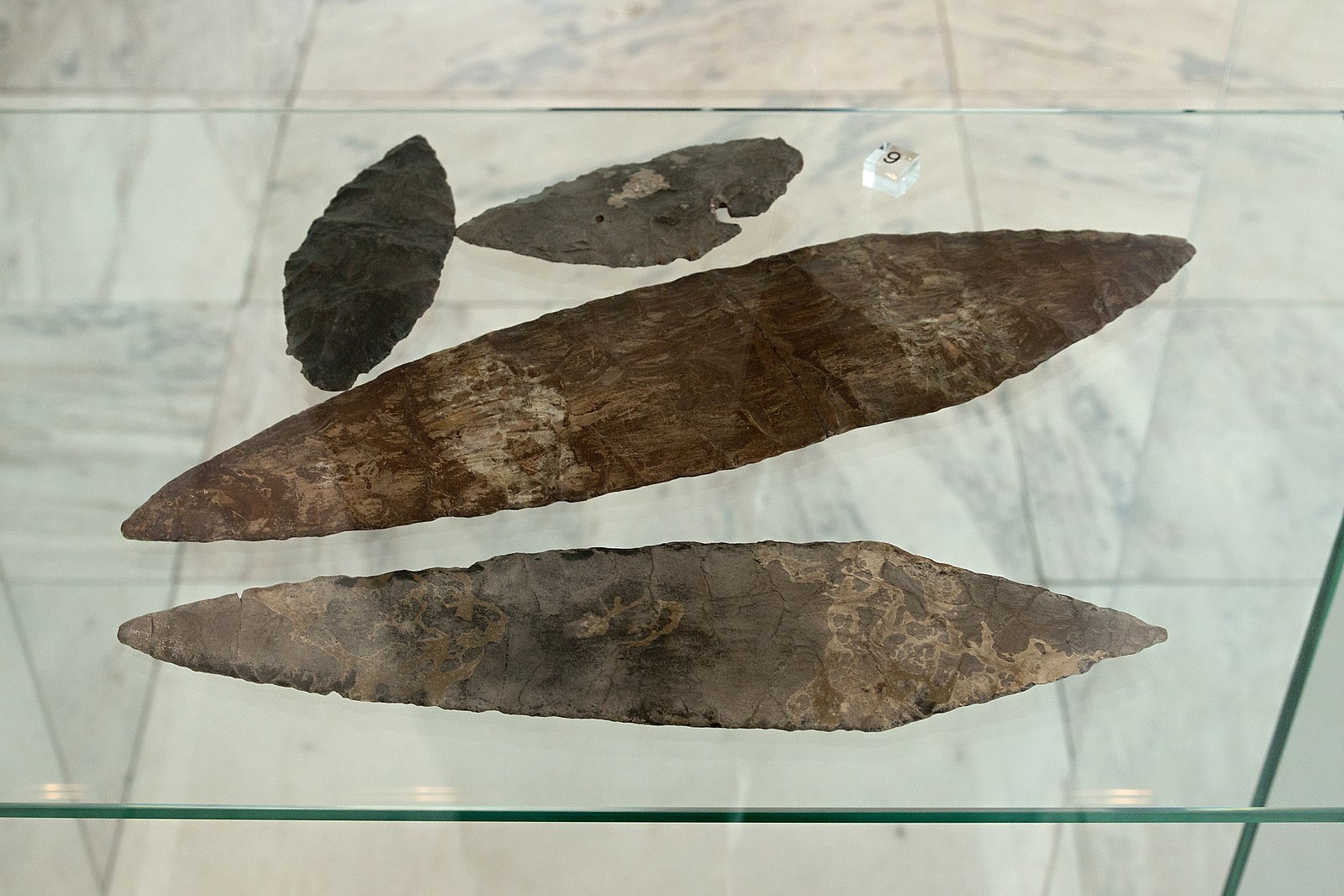
As food gathering techniques evolved for these Paleolithic foragers, so did their behavior as organized groups. These humans became mobile to prevent resource depletion; they controlled population through dispersion or infanticide. And they began to emphasize cooperation. Foragers also began to divide tasks and share food with others, a feature that distinguishes them from other animals like chimpanzees that live in communities but feed individually.
Sharing food is, of course, much easier to do when there is a surplus. With increased tool use, Paleolithic humans became even more adept at foraging, leading to higher likelihood of food surpluses. Paleolithic peoples had material goods – they created, kept and even traded rudimentary tools, valuing those items which enabled survival. But accumulation of tools and goods was not a priority, not an end in itself. For a population that must move, in some cases migrating often and across long distances, material goods had value only if they served a specific and immediate purpose. What we consider today a measure of wealth – lots of things – was a burden for a nomadic population. Accumulation of goods was not valued because it was not an asset to survival in a nomadic lifestyle. As a result, no structured distinctions developed between peoples based on the goods they possessed.
Property or land ownership also made little sense for Paleolithic peoples. Tribes might lay claim to a particular territory for resources during a specific season but a claim was temporary. Permanent claims to a plot of land made no sense when a tribe might roam miles to gather or hunt, and move to a new region on a seasonal basis. Individual land ownership was unknown in a communal, nomadic tribal setting where reciprocity was the norm. Fundamental aspects of economic life taken for granted in later civilizations did not exist for a nomadic Paleolithic population. There was no emphasis on individual land ownership nor an emphasis on the accumulation of things. The shift to agriculture which led to more complicated economic and social systems in settled civilizations dramatically changed these societal patterns.
Use of tools not only helped humans live cooperatively but may have helped hominids develop abstract thought; evidence of tool use may give us a clue as to when this development began. As far back as 2.6 million years ago, we see evidence of the creative thinking required to make more effective tools. Homo habilis in fact takes its name (“handy man”) from the fact they were the first known hominid tool-makers. Soon after individual tools appeared, the Oldowan Industry became the first widely used toolset, “consisting of flaked and smashed quartz riverside pebbles made into poorly formed choppers and sharp stone flakes, [and] lasted for 1 million years with little change [from 2.6 to 1.5 million years ago].”[8] The Oldowan were followed about 1.5 million years ago by hand axes that remained unchanged for more than a million years. Many scholars argue these smaller-brained hominids like Homo habilis, homo ergaster, and Australopithecus were both unable and unwilling to innovate much beyond their simple but effective tools, especially considering how harsh their environment could become. Fire was another important tool, first used by Homo erectus about 1.6 million years ago. Fire became important for migrants to colder climes in Europe and Asia, and to foragers who could now eat foods that were poisonous if ingested raw. Homo erectus also cooked foods they had previously eaten raw, thereby expanding their lifespan by eliminating toxins found in raw meats.
Homo sapiens would add more meat to their diet when advances in tool-making led to an increase in big game hunting during the late Pleistocene. For example, excavations near Dolni Vetoniçein the Czech Republic have helped reveal a society that made multiple uses of downed mammoths: meat, fuel, building material, and for the creation of art such as jewelry. The inhabitants of Dolni Vetoniçe also made thousands of ceramic figurines, bird bone flutes, and ivory carvings of human heads.
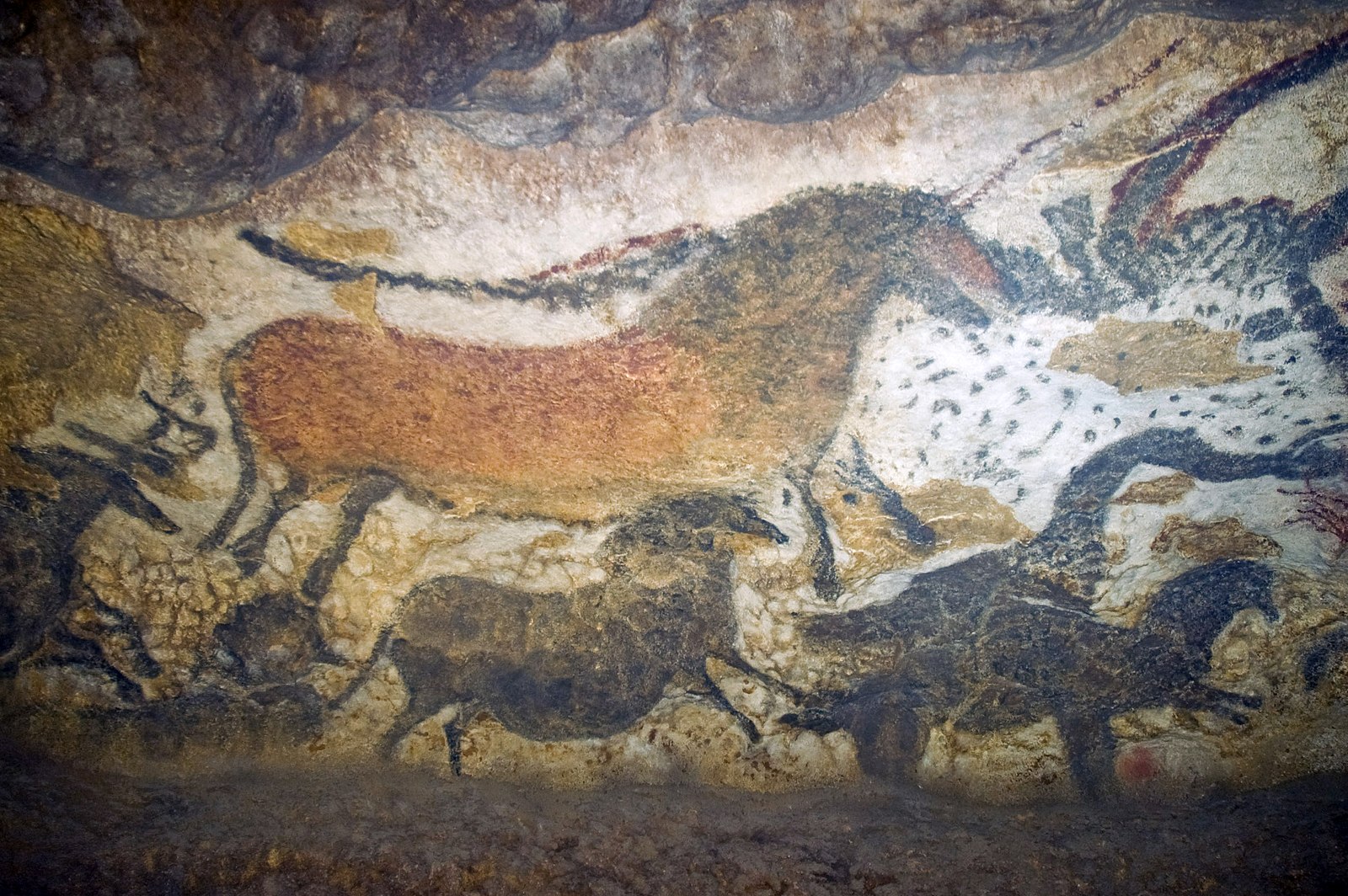
The famed paintings of the Lascaux caves vividly reflect increased skills as hunters and painters. The colors and types of paint used were vibrant and durable, and the scenes depicted demonstrated the use of diverse hunting techniques. On these walls we see depictions of humans hunting not only deer, but also woolly rhinoceros and mammoths. Lascaux paintings provide evidence that hunter-gatherers had religious beliefs, as well as the existence of gender specific tasks, reflecting a sophistication usually only attributed to sedentary humans. The fact humans and animals were depicted together so often at Lascaux may be evidence of their belief man descended from these animals. Or perhaps the bison, rhinoceri, and birds were painted on walls to produce “hunting magic” to make expeditions more successful. Mostly men were depicted in these higher-risk hunting activities, suggesting perhaps women were the artists, or participated less in the hunt, or both. Increased sophistication was not limited to big game hunters. Campsites, rock art, and burial sites near Lake Mungo in Australia reveal how these early humans used pottery for cooking and had a diverse diet of birds, fish, and shellfish, a diet that seems to have kept them well-nourished.[9] Later Paleolithic women likely began to experience a growing role, reflected in the female representation of the “Venus” statuettes. As we get closer to the Neolithic era, we see the rising relative importance of women: their place in rituals increased, their stature increased, their economic importance increased, and their childbearing uniqueness became more emphasized.
Reading the Past – Visiting the Lascaux caves
Watch the video: “Virtual tour of prehistoric caves at Lascaux, France,” Musee DʻArcheologie Nationale.
Link: https://archeologie.culture.fr/lascaux/en/node/9028/puits
Current Debate: The Anthropocene
Those who deal with the past, whether geologists, oceanographers, sociologists or historians, use dividing lines to identify differences and transitions between past events and experiences. Scientists and historians are currently debating whether we should refer to our present age as the ‘Anthropocene’, characterized as an era when humans replaced nature as the most impactful force on earth. The Oxford English Dictionary added this new word in 2014, defining the Anthropocene as the “…era of geological time during which human activity is considered to be the dominant influence on the environment, climate, and ecology of the earth” (Oxford English Dictionary 2014).
Those advocating the term Anthropocene point to decades of evidence about human impact on the environment, in particular through generation of greenhouse gasses. The first written reference to a possible ‘greenhouse’ effect dates back to the early 19th century. By the second half of the 20th century warnings issued by the scientific community had grown in number, urgency and impact. In 1985, climate scientists produced an influential report warning of dangerous effects of CO₂. In response, the United Nations created the Intergovernmental Panel on Climate Change (IPCC) in 1988. The IPCC was charged with assessing and recommending policy to address climate change consequences, and has issued several reports over the past 35 years. In 1989 naturalist author Bill McKibben wrote The End of Nature, considered the first book about climate change and global warming written for a general audience. Numerous scientists, research groups and publications continued to draw attention to human-caused environmental effects, including the influential 2004 report from the International Geosphere-Biosphere Programme titled “Global change and the Earth System.” This report presented evidence of human impacts on the changing atmosphere, decreased biodiversity, transformation and destruction of natural habitats, diversion of rivers, and pollution of the ocean.
Scientists Paul Cutzen and Eugene Stoermer are credited with first using the term Anthropocene, arguing the impact of humans on Earth’s natural systems has become so significant and consequential that this new era deserved a geological epoch name. Debate continues about whether this term should be accepted. Some critics feel the term Anthropocene overstates human effects versus the natural forces that contribute to environmental conditions, such as the Earth’s shifting rotational position. Other critics emphasize that for most of human history, human actions impacted regional ecosystems rather than produced global effects, for example contributing to species extinction specifically in the Americas, Australia, or the Pacific Islands. Another criticism is that all other geological epochs refer to vast stretches of time, usually millions of years, so the relatively brief period of humans (homo sapiens) and their impact does not match this traditional geological time span. Further, there is no agreed upon geological ‘marker’ to identify when this proposed new age begins, little physical evidence in the layers of ice or soil or tree rings where a clear dividing line can be identified. A geologically named epoch without a physical geological marker breaks with existing scientific practice. Finally, some point to the fact we are already in a formally identified epoch, the Holocene epoch, which began with the end of the last ice age. This is a geologically clearly marked division in Earth’s history and it is confusing to differentiate from this age.
Yet use of this term continues. For those who identify an Anthropocene era, the dilemma is when to start this era – what event or change marked the start of the ‘human’ era in Earth’s natural history? Some argue the Anthropocene began with the hunter-gathering phase since there is clear evidence human actions transformed local environments as early as the late Pleistocene, the beginning of the Holocene epoch, as humans mastered the use of fire. Fire was used to burn forests, creating grassy areas to increase the number of grazing animals to hunt as well as reduce cover for feared predators. As forests and existing flora were burnt, soil changed and new crops grew, changing ecosystems. Hunter-gatherers also contributed to, or were even a primary cause of, the extinction of large mammals (‘megafauna’) such as giant sloths and sabre tooth cats. The scientific consensus is the combined impact of humans and climate shifts caused the massive collapse in populations of large land mammals.
Others argue the Anthropocene epoch began with the Agricultural Revolution, as humans increasingly relied on cultivated agriculture and domesticated animals between 10,000 – 7,000 BCE. Native grasslands were plowed over and forests cleared for planting and grazing animals, leading to erosive effects on soil, diversion of waterways, and dense urban settlements that produced increased waste and required heavier use of resources. Reliance on domestic animals meant displacement and decline of native animal species. All these consequences directly and significantly impacted ecosystems, as we address in later chapters.
Another compelling argument is the Industrial Revolution represented the start of the Anthropocene era, as humans dramatically accelerated their impact on the environment through advances in science, technology, production, mass consumption, and the insatiable hunger for power sources. Starting in the late 1700s and continuing to the present, reliance on fossil fuels resulted in transformative effects on the atmosphere and climate. Another proposal for the start of the Anthropocene era is quite specific – July 16, 1945 – when the first atomic bomb was tested, releasing radioactive isotopes into the atmosphere. This date is favored by scientific purists since identifiable geological markers from radiation fallout can be detected in nature. Finally, some feel the Anthropocene era should be identified as starting in 1950 since during the latter part of the 20th century, the intensity of human impacts dramatically escalated, referred to as the Great Acceleration. As human population and consumption significantly increased, consequences of human actions were far more evident globally.
While it is difficult to point to a consistent global ‘marker’, clearly humans have had a major impact on the environment, an impact that is escalating with growing populations and intensive consumption patterns. In later Chapters we touch on examples of ways societies impacted, and were impacted by, changes in soil, water, forests, species extinctions, diseases and climate change. We are acutely aware of the fact that today the planet’s natural processes are undergoing dramatic changes which directly impact the natural world and human conditions. More intensive and destructive forest fires, droughts, and floods are devastating communities across the globe. Island and coastal communities such as Pacific societies find themselves vulnerable to devastating effects of rising seas and more extreme weather events. Sea levels in the western Pacific are increasing two to three times faster than the global average, intensifying flooding, contamination of fresh water supplies, and destruction of agricultural lands and essential habitats. Entire communities are displaced as islands and atolls shrink. The Hawaiian islands, for example, are predicted to undergo sea-level rises of 1 foot by 2050, and 3 feet by the end of the 21st century. Such dramatic changes mean significant disruption and dislocation, transforming communities as well as impacting island plants and animals.
Whether the term Anthropocene is used officially or not, we are today certainly more aware of the impact human actions have on the environment. The need for mitigation and resilience is paramount in the face of new realities of this Anthropocene era. How we respond to serious challenges of climate change and other environmental crises is one of the most important tasks for us as 21st century citizens of the globe. The study of history, including the earliest beginnings of human societies, provides us valuable lessons to learn from to support that goal.
Footnotes:
[1] J.E.G. Sutton, “Archeology and Reconstructing History in the Kenya Highlands: The Intellectual Legacies of G.W.B. Huntingford and Louis S.B. Leakey.” History in Africa 34 (2007), p. 313.
[2] Lauren Ristvet, In the Beginning: World History from Human Evolution to the First States. 1/e. (New York: McGraw-Hill, 2007), p.4.
[3] Ristvet, 3-5.
[4] Almudena Estalrrich, and Antonio Rosas. 2015. “Division of Labor by Sex and Age in Neandertals: An Approach through the Study of Activity-Related Dental Wear.” Journal of Human Evolution 80 (March): 51–63. https://doi.org/10.1016/j.jhevol.2014.07.007.
[5] Ristvet, 24-26.
[6] Clive Gamble, Timewalkers: The Prehistory of Global Colonization. Stroud: Alan Sutton Publishing Ltd., 1993), pp. 125-128.
[7] Tom D. Dillehay, Carlos Ocampo, José Saavedra, Andre Oliveira Sawakuchi, Rodrigo M. Vega, Mario Pino, Michael B. Collins, et al. 2015. “New Archaeological Evidence for an Early Human Presence at Monte Verde, Chile.” Edited by John P. Hart. PLOS ONE 10 (11): e0141923. https://doi.org/10.1371/journal.pone.0141923, p. 208.
[8] Ristvet, 17-22.
[9] Ristvet, 27-30.

